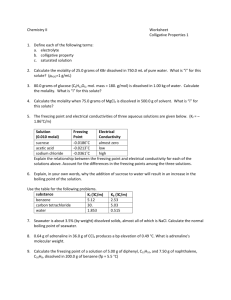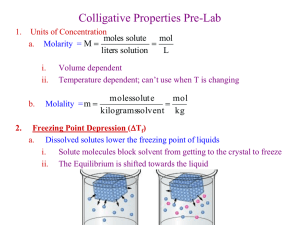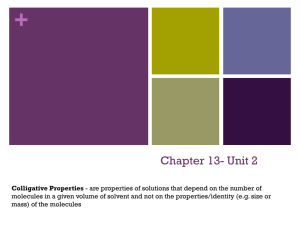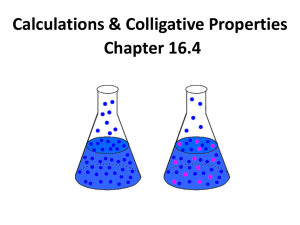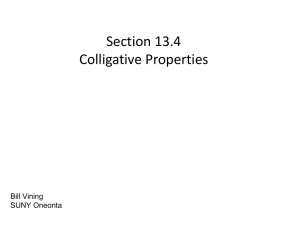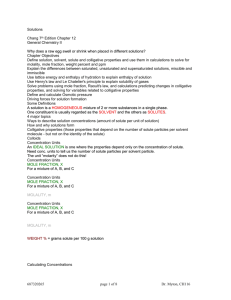blog.3-4.Colligative Properties
advertisement
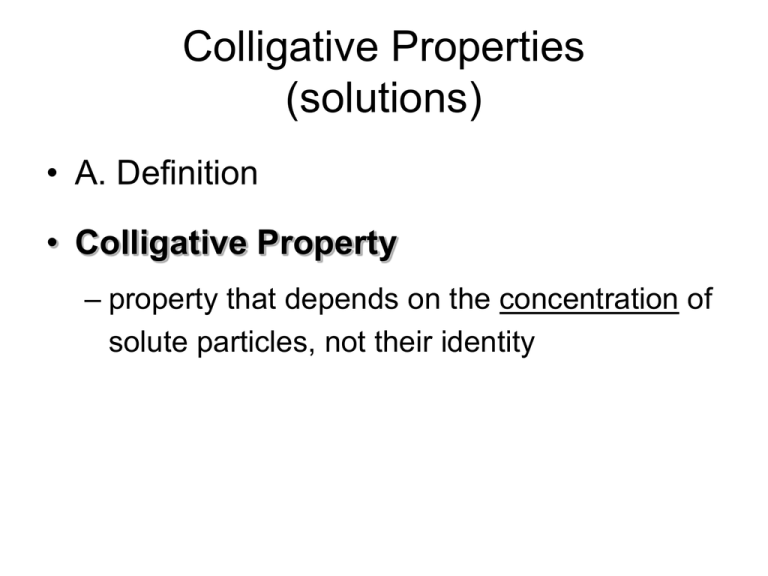
Colligative Properties (solutions) • A. Definition • Colligative Property – property that depends on the concentration of solute particles, not their identity 4 Colligative Properties • • • • Vapor-pressure Freezing point Boiling point Osmotic pressure Vapor pressure • vapor pressure is the measure of the tendency of molecules to escape from a liquid • volatile- high vapor pressure • non-volatile- low vapor pressure • vapor pressure lowering depends on the concentration of a nonelectrolyte solute and is independent of solute identity, it is a colligative property • because vapor pressure is lowered, this lowers the freezing point and raises the boiling point. Freezing Point Depression • (tf) - is the difference between the freezing points of the pure solvent, and it is directly proportional to the molal concentration of the solution. – f.p. of a solution is lower than f.p. of the pure solvent • the freezing point of a 1-molal solution of any nonelectrolyte solute in water is found by experiment to be 1.86°C lower than the freezing point of water. • Molal freezing-point constant, K, is the freezing point depression of the solvent in a 1- molal solution of a nonvolatile, nonelectroyte solute • Each substance has a different molal freezing point constant (p. 438) • Applications – salting icy roads – making ice cream – antifreeze • cars (-64°C to 136°C) • ∆tf = Kf mi ∆tf = freezing point depression (°C) Kf = °C/ m m = mol solute/kg of solvent i = # of particles Boiling Point Elevation • (tb) – b.p. of a solution is higher than b.p. of the pure solvent – When the vapor pressure is equal to the atmospheric pressure boiling will occur. – molal boiling point constant (kb ) is the boiling-point elevation of the solvent in a 1-molal solution of a nonvolitle, nonelectrolyte solute. (0.51 °C/m) – Boiling-point elevation,∆tb , is the difference between the boiling points of the pure solvent and a nonelectrolyte solution of that solvent, and is directly proportional to the molal connection of the solution. • ∆tb = Kb m i ∆tb = boiling-point elevation (°C) Kb = °C/ m m = mol solute/kg of solvent i = # of particles Osmotic pressure: • • • Semipermeable membranes allow the movement of some particles while blocking the movement of others. Osmosis: the movement of solvent through a semipermeable membrane from the side of lower solute concentration to the side of higher solute concentration. Osmotic pressure is the external pressure that must be applied to stop osmosis. • Electrolytes: remember dissociation of ionic compounds • NaCl lowers the freezing point twice as much as sucrose C12H22O11 – NaCl Na+ + Cl- • CaCl2 lowers the freezing point three times as much as C12H22O11 due to the dissociation of the ionic compounds – CaCl2 → Ca2 + + 2Cl- C. Calculations t = k · m · i t: change in temperature (°C) k: constant based on the solvent (°C·kg/mol) (different depending on freezing or boiling) m:molality (m) i: # of particles • # of Particles – Nonelectrolytes (covalent) • remain intact when dissolved • 1 particle – Electrolytes (ionic) • dissociate into ions when dissolved • 2 or more particles When we dissolve most ionic substances in water they break up into their individual ions. NaCl(s) Cl- (aq) + Na+ (aq) Most molecules don’t break up into ions. For example sugar. C12 H24O12 (s) + H2O (aq) C12 H24O12 (aq) But some molecules do break up into ions. Acids and bases are examples. HCl(l) + H2O (aq) Cl- (aq) + H3O + (aq) Dissociation Equations ( ionic ) i = 2 NaCl(s) Na+(aq) + Cl-(aq) i = 2 AgNO3(s) Ag+(aq) + NO3-(aq) MgCl2(s) Mg2+(aq) + 2 Cl-(aq) i = 3 i = 3 Na2SO4(s) 2 Na+(aq) + SO42-(aq) AlCl3(s) Al3+(aq) + 3 Cl-(aq) i = 4 C. Calculations • At what temperature will a solution that is composed of 0.73 moles of glucose in 225 g of phenol boil? GIVEN: WORK: b.p. = ? m = 0.73mol ÷ 0.225kg tb = ? tb = (3.60°C·kg/mol)(3.2m)(1) kb = 3.60°C·kg/mol tb = 12°C m = 3.2m b.p. = 181.8°C + 12°C i=1 b.p. = 194°C tb = kb · m · i C. Calculations • Find the freezing point of a saturated solution of NaCl containing 28 g NaCl in 100. mL water. GIVEN: f.p. = ? tf = ? kf = -1.86°C·kg/mol WORK: m = 0.48mol ÷ 0.100kg tf = (-1.86°C·kg/mol)(4.8m)(2) m = 4.8m i=2 tf = kf · m · i f.p. = 0.00°C - 18°C tf = -18°C f.p. = -18°C What is the boiling point of a solution made by dissolving 1.20 moles of NaCl in 750 g of water? What is the boiling point? Δtb = kb .m.i Find molality! Molality=1.20moles/.750 kg molality= 1.6 m Δtb = (0.51°C/m)(1.6m)(2) Δtb = 1.63°C Boiling pt: 100 + 1.63= 102 °C Ex: What is the freezing point depression of water in a solution of 17.1 g of sucrose, C12 H22O11 , and 200. g of water? What is the actual freezing point of the solution? • Δtf = kf .m.i • Molar mass of sucrose is 342.34 g/mol • Find moles: 1m ol 17.1g 342.34g • = 0.04995 mol • Molality= 0.04995 moles/.200 kg • molality= 0.2498 m • Δtb = (-1.86°C/m)(0.2498m)(1) • Δtb = - 0.465°C • Ex: A water solution containing an unknown quantity of a nonelectrolyte solute is found to have a freezing point of -0.23°C. What is the molal concentration of the solution? Δtf = kf .m.i -0.23 °C = (-1.86 °C/m)(x)(1) -0.23 °C = x -1.86 °C 0.12 m = x • Ex: What is the boiling point elevation of a solution made from 20.0 g of a nonelectrolyte solute and 400.0 g of water? The molar mass of the solute is 62.0g/mol. • Find molality first: 20.0 g / 62.0 g/mol • Molality = 0.3226 mol/0.400 kg=0.806 m • Δtb = kb .m.i = (0.51 °C/m)(0.806 m)(1) = 0.411 °C • Ex: What is the expected change in the freezing point of water in a solution of 62.5 g of barium nitrate, Ba(NO3 )2 , in 1.00 kg of water? • Molality= 62.5 g/261.36 g/mol =0.2487 m • Δtf = kf .m.i = (-1.86 °C/m)(0.2487 m)(3) = 0.746 °C Assignment: • • • • Do practice problems 1-4 on page 440 Do practice problems 1-4 on page 441. Do practice problems 1-3 on page 445 Practice problems have answers off to the right.

